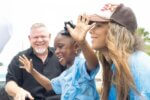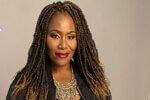Elizabeth Copeland–one of a handful of African American missionaries on the foreign field today–is reaching a primitive Philippine tribe that was displaced by a volcanic eruption.
As soon as they hear the rumbling of the car cease, the small, dark-skinned people of Sapang Bato, a remote village in Pampanga province in the Philippines, march out of their coconut-thatched huts toward the tiny chapel. Women with babies in their arms and five or six toddlers in tow stream toward their house of worship, greeting the incoming evangelist, Elizabeth Copeland, with smiles draped across their faces.
Reared on the spirited sermons of two Pentecostal preachers, Copeland delivers a rousing message that brings these Filipino worshipers to their feet. As pastor Samuel Suarez interprets, the tiny congregation erupts in jubilant praise. Then a holy hush fills the room, and all that can be heard are the voices of small children and the gentle whisper of these believers.
Ten years ago, the villagers of Sapang Bato, an aboriginal Philippine people known as the Aeta, lived secluded in the mountains. Shunned because of their dark skin tone and coarse hair, the Aeta were displaced from their homes when Mount Pinatubo erupted in 1991. Relocated to a government resettlement area devoid of electricity and water, the Aeta lived in stark poverty, with no change in sight.
That is, until they met Copeland, a missionary with the Church of God in Christ (COGIC), the largest Pentecostal denomination in the United States. Beginning her work in the Philippines in 1997, Copeland, a former fashion designer, set up factories to manufacture the Aetas’ unique woodcarvings and intricately woven fabrics. While most factories pay their workers $3 a day, hers, funded by ministry supporters, pays $10 a day.
It’s one example of how Copeland ministers to the Aetas’ physical needs in order to reach them with the gospel. “I’ve been traveling to the Philippines for four years, and I’ve watched the power of God transform the lives of people who have lived in abject poverty and spiritual barrenness,” says 63-year-old Copeland.
That power changed Copeland’s own life. After battling chronic illness for 30 years, Copeland was miraculously healed. Yet it would take her another 20 years to realize that God’s call on her life would lead her down a road less traveled–and make her one of a handful of African Americans in foreign missions.
A Missionary by Design
Copeland started out in life as a sickly youngster. Born with a deformed ear, she contracted malaria at 2 months, and doctors gave her three to six months to live. She beat the odds, then at age 5, witnessed her first creative miracle.
“My left ear was a lump of flesh,” she says, “but I heard my mother pray for healing over other people, and I asked her to pray for God to give me a left ear.” Within a year, she says, her left ear was normal.
Discovering a gift for sewing, Copeland pursued fashion design and attended the Chicago School of Design at age 13. She began earning extra money by creating fashions for her community, and later for celebrities such as Sammy Davis Jr., the Supremes and Fats Domino.
Yet the malaria had created chronic kidney problems. Because she was ill frequently, Copeland stayed close to her mother, a COGIC missionary, traveling with her as she preached across the United States and Canada. Even after she married in July 1955 at age 17, Copeland continued traveling with her mother as well as pursuing fashion design.
Ironically, it was her glamorous career that introduced her to the plight of the Third World. Traveling to Haiti for a design project, Copeland says she ventured to the “wrong side of the country.”
“[People] were sleeping in the streets. I said, ‘I don’t ever want to come here again–never!'”
But before the short flight from Haiti to Miami ended, Copeland had devised a plan to help the impoverished nation. “I had read a book about how people in the city would grow gardens in boxes in the window sill. I thought…why can’t we build a big box? We started doing it in the villages and built grow-boxes [that] would feed a family of four.”
She traveled to various Caribbean nations during the next 15 years, helping people care for themselves–though she still refused to call herself a missionary. Then in 1968, after miraculously having had three children of her own, Copeland was diagnosed with cancer. Doctors again gave her up to die.
As she lay alone in her house, she says she heard God tell her to get on her knees and pray. “I got on my knees, and I heard the Lord say, ‘Look up.’ I felt God’s hand on me, and I knew I was healed.”
When she returned to the doctor, he couldn’t find anything wrong with her. “I knew God had healed me for a reason and that I had a calling on my life, but I still didn’t accept it right away. I wanted to be a wife. I could vacuum for the first time in my life. I wanted to be a wife and a mommy.”
But running from her calling soon proved expensive. A gang broke into her Fort Lauderdale, Florida, home and stole a valuable coin collection she had kept since childhood. The youths were apprehended and about to be put in juvenile detention when Copeland says the Lord spoke to her spirit.
“The Spirit of the Lord told me that those children should not be put in jail and that instead I should form a group that would minister to them,” she recalls.
Her youth group became known as I Care Ministry, which later evolved into Yes I Can Ministry. She took the teens into her custody and taught them to make crafts they could sell. “I really enjoyed it,” Copeland says. “We went to the governor’s mansion and the White House [to receive special commendation]. I really thought this was what the Lord wanted me to do.”
But one day in 1988, she suddenly fell ill after 20 years of good health. She was on the floor in her home and couldn’t move. “The Lord told me I had done many good things, but I still hadn’t answered the call…to be the whole person He called me to be.”
She says she had given away thousands of dollars, adopted four children, helped educate 34 others without any assistance–but because she wanted to, not because God told her to. “God said: ‘I want you to do it for Me. I will give you the blessings to go all over the world if you’ll say yes.’ I said yes, and then I was able to get off that floor and get some sleep.”
Reaching the Least of These
In 1990, she went back to Haiti, and with the help of engineers from the University of Florida, Copeland built PVC pipes that delivered water to the villages–enabling the people to draw water from faucets for the first time in their lives.
She travels for several weeks to various nations then returns to her home in Daytona Beach, Florida. It pains her to leave her family, but she says that now, unlike during her childhood, missionary work is no longer a chore. “It’s not something I dread doing. It’s something I look forward to doing,” she says.
In 1997, COGIC appointed her jurisdictional supervisor of ministries to women in the Philippines. Women such as Copeland are assigned to remote countries by the general supervisor of the denomination’s women’s department, Mother Willie Mae Rivers.
“Part of my job is to send female missionaries to other countries so they can train and raise up godly women in that tribe who will eventually offer spiritual training to fellow native women,” Rivers says.
A rarity abroad, African Americans don’t typically pursue mission work on foreign soil. Copeland says many African Americans simply are not aware of the great need or unique opportunities available to black missionaries.
“I’ve found there are a lot of people who would like to go, especially to the foreign field, but there is a need for training,” Copeland says.
Missionary JoAnna Rochester observed the same challenge. After traveling on international crusades with evangelist Marilyn Hickey, Rochester sensed the call to missions, though at the time she had never met a black missionary. After spending eight years on the field in Nigeria, she founded Every People, Tribe and Nation Evangelistic Association (EPTN) in Detroit to train African Americans in missions.
Rochester says 40 to 60 students attend the four-month training sessions each year and participate in mission trips all over the world. “I think because the world is mostly of color–three-fourths of the world is nonwhite–we can blend in easily. Also, because…black Americans have gone through slavery…we understand struggle.”
When the field grows dangerous, 48-year-old Rochester observes, African Americans are less likely to give up. “God has put something on the inside of us,” she says, “a determination.”
Copeland has had to draw on that determination a time or two as she has worked in the Philippines. In many ways, Copeland says, the Philippines was like Haiti all over again.
Plight of the Poor
The average family in Sapang Bato consists of two adults and seven children, huddled together in a 12-by-12 shack. “Home to these people is usually a makeshift structure made of old plywood and coconut leaves without plumbing or toilet, without electric power and definitely unfurnished,” Copeland says.
Food is scarce, and residents of Sapang Bato buy their water from a nearby community, paying 10 cents for a small pail. “We always pray to Guni [translated “God”] to provide us food and water even just for the children,” explains 82-year-old churchgoer Terry Villanueva, grandmother of 30.
Frequent disease, especially among the children, is a consequence of unsanitary living conditions caused by a lack of water. A majority of the Aeta people can neither read nor write after having lived in seclusion in the mountains.
Copeland says the small community church is doing its best to educate people about the truths of the Bible, but she says they need financial assistance to help alleviate horrible conditions in Sapang Bato.
Although it is heavily forested, the land is fertile, so Copeland hopes that with some help the people can soon grow their own food. She would also like to bring in people who could teach the Aeta how to start chicken farms to earn extra money for their families.
Besides the ministry to the Aeta, COGIC oversees the work of about 40 churches across the islands. Their headquarters in Angeles City in Pampanga province also houses a Bible school for the denomination’s indigenous pastors.
Copeland hopes to one day find a way to fight the exploitation of young Filipino women, some of whom engage in prostitution as young as 10 or 12, she says. “I make it a point to let them know there is a better life. But you can’t tell them there is a better life without offering them that better life.”
Having ministered around the world, Copeland has learned the common language of need and fragile hope that is shared by all the world’s poor. “Everywhere I go around the world, I can understand the language of the people,” she says. Copeland hopes that all Christians will someday learn that language too. *
Zenet Maramara is a development professional living in Manila. If you would like to contribute to Elizabeth Copeland’s work in the Philippines, send your tax-deductible donation to Christian Life Missions, Attn: Philippines Project, P.O. Box 952248, Lake Mary, FL 32795-2248.






Leave a Comment
You must be logged in to post a comment.